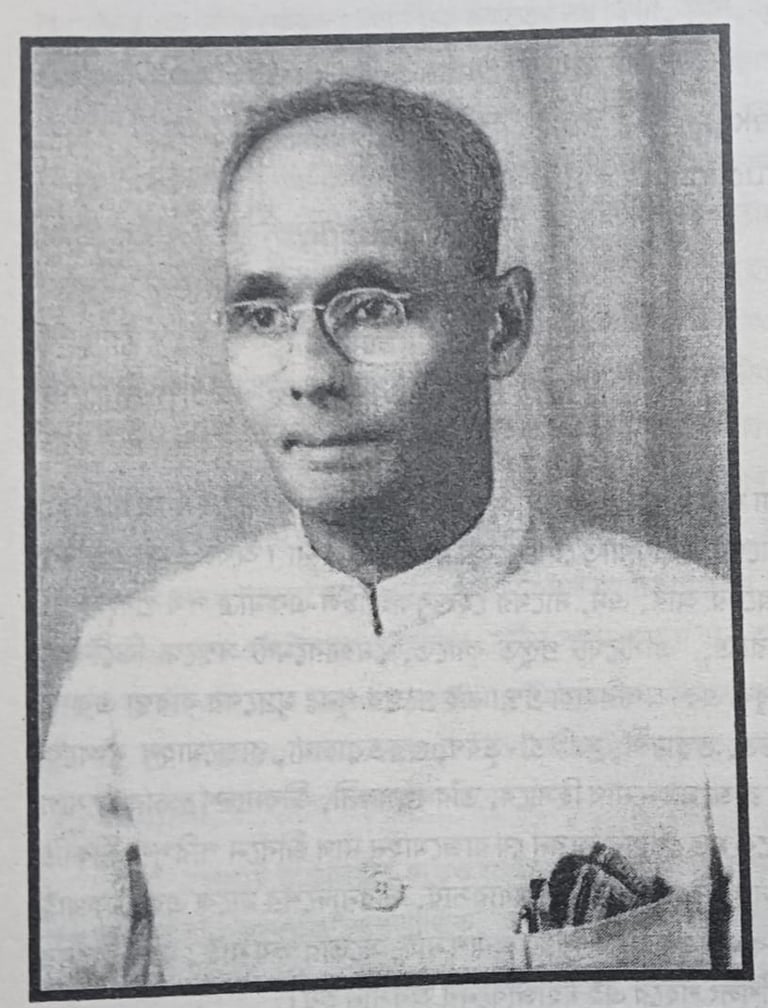About Rajmohan Nath
Rajmohan Nath (1899–1965) was a pioneering engineer, archaeologist, and scholar whose life’s work left an indelible mark on Assam’s educational and cultural fabric. Born in Rangauti village of Hailakandi district, he rose to become one of the most respected intellectuals of his time.
He served as the founding and caretaker Principal of Assam Engineering College (AEC), the first undergraduate engineering college in Northeast India. AEC was incubated under the Assam Engineering Institute (AEI) in 1955, starting with just 72 students in the Civil Engineering department. Under his stewardship, the institution laid a strong foundation for technical education in the region. His vision and administrative leadership made him a central figure in shaping the college’s early years.
Rajmohan Nath was also a passionate archaeologist and historian. His celebrated works like The Back-ground of Assamese Culture and Northeast India: Gateway to Glory are still referenced for their depth and historical insight. A polymath in the truest sense, he bridged the worlds of engineering, heritage, and literature.
To preserve his legacy, the Rajmohan Nath Memorial Foundation was established. It is committed to documenting his life through a documentary, digitizing and republishing his literary works, encouraging academic research on his contributions, and building a digital archive and memorial center.


Early Life and Education:
Rajmohan Nath was born on October 31, 1899 in a then very backward village named Rangauti Gaon at Hailakandi, in Cachar district. His father was Govind chandra Nath and mother was Gauri Devi. He Was though born to a very poor family but was exceptionally intelligent and clever from a very young age.
Rajmohan Nath’s early education was marked by brilliance. He completed his matriculation in 1918, standing first in the entire northeastern region during the HSLC examination conducted by Kolkata University, making all Assamese proud. Following the same, he cleared ISC (Intermediate Studies) from Sylhet Murari Chand College and took admission in Shibpur Engineering College (now Known as the Indian Institute of Engineering Science and Technology, Shibpur) in the year 1921. He passed out as a Civil Engineer standing first class first in the year 1925.
Contribution to AEC
Rajmohan Nath’s involvement in the birth of AEC was not just professional—it was profoundly personal. He stepped in at a time when there was no campus, no defined structure, and only a handful of faculty. With just 72 civil engineering students, he carried the weight of building an institution—almost single-handedly.
AEC was born within the Civil Engineering department of AEI, and Rajmohan Nath transformed it from an idea into a living, breathing institution. He wasn’t just shaping classrooms—he was shaping futures. He worked tirelessly to craft the college’s academic structure, guided student discipline, and created an ethos of excellence that continues to define AEC.
His leadership was grounded in empathy, intellect, and an unshakable belief in the power of education. He nurtured those first batches of students like a guardian, making sure their foundation was strong, their aspirations high, and their path clear. He wasn’t just building a college—he was building a legacy.
Career:
After the completion of his engineering studies, he joined Assam Public Work and eventually rose to the position of Executive Engineer with his expertise and dedication. During this time, he worked on some significant projects such as designing the Barnihat River bridge in the Khasi-Jaintia Hills. He contributed his tenure to Golaghat, Jorhat, Nagaon, Guwahati and Shillong and he was keen interested in discovering the undiscovered historical remains where ever he was posted and proudly said "if we knew the past, we knew the present."
In 1955, Nath became the Principal of the Assam Engineering Institute and played a key role in establishing the Assam Engineering College at Jalukbari, Guwahati. Alongside his engineering work, he dedicated himself to archaeological discoveries, unearthing ancient temples, inscriptions, and stone monuments in Sonitpur, Nagaon, Cachar, and beyond. His most notable finds include the Shiva temple ruins at Da-Parbat and Bamuni Pahar and the ways to unfold the history of the famous Padum Pukhuri.
Nath’s work extended beyond Assam, as he contributed significantly to the study of the Indus Valley Civilization during the Harappa excavations (1920–1924). He after completion of his study works over there and gaining immense knowledge from his mentors wrote the very famous “A clue to the Indus-Valley Script and Civilization”. His writing gained him a worldwide recognition.
Archaeological Contributions:
Rajmohan Nath played a big role in Assam's archaeology combining his engineering skills with his history studies. As a civil engineer, he got excited about finding old artifacts during his work. One of his best finds was the ruins of a Shiva temple at Da-Parbat in Tezpur, which Assamese people call the "Shilar Gate." This discovery showed how good early Assamese temple builders were. His work at Bamuni Pahar also turned up detailed sculptures and old temple parts showing the area's great art traditions.
In Nagaon, Nath found proof of the "Kadali Rajya" kingdom helping historians learn more about Assam's middle ages. His search of the Padum Pukhuri site in Tezpur brought to life tales of the Kamrup kingdom and how its culture grew. Nath also tried to figure out writing on old stone monuments, which told us a lot about Assam's political and religious past. On a bigger scale, Nath's work on the Harappa digs of the Indus Valley Civilization was key. These efforts not only enhanced knowledge of Assam’s past but also established him as a respected figure in Indian archaeology.
Literary Works:
Rajmohan Nath was a famous writer. Who wrote incredibly in the form of journals, research papers and many more. He wrote about 37 books in various Indian languages other than Assamese. In English, he wrote, the famous of all-time "The back ground of Assamese culture", Clue to the Indus valley scripts and civilization, Trade route in Ancient Assam, Chronology of Kamprup Kings, Nath handbook of civil Engineers. He also published various books with an oath to conserve the famous Borgeets of Mahapurush Shri Shri Shankar Dev, and Shri Shri Madhav Dev.


